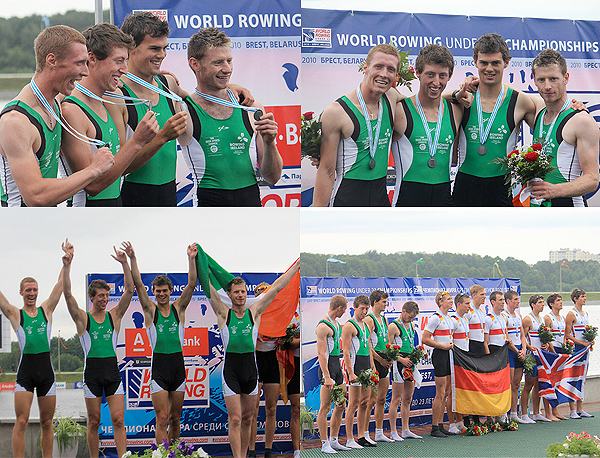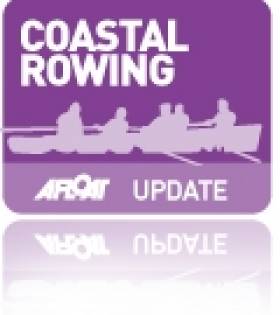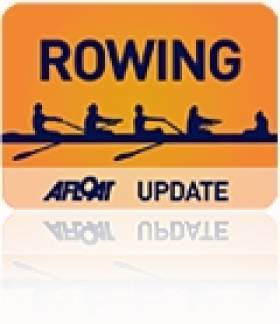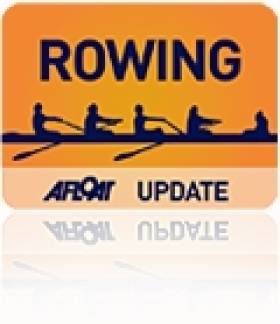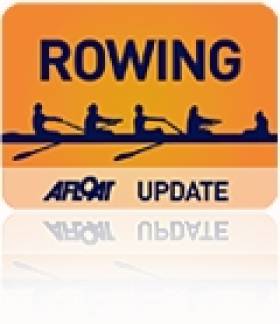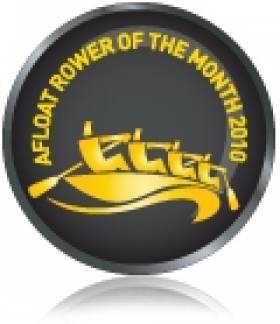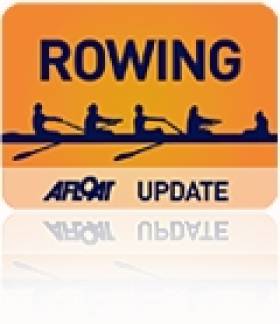Displaying items by tag: rowing
Hughes Fifth in World Championship Semi
Turlough Hughes finished fifth in the semi-final of the men’s single scull at the World Junior Championships in Racice, Czech Republic. The race was won by the reigning world champion, Felix Bach of Germany, with Jakub Podrazil of the Czech Republic second. Andrew Campbell of the United States took the third A Final qualification place. Hughes is now destined for tomorrow’s B Final, which determines places seven to 12.
World Junior Championships, Racice, Czech Republic, Day Three (Irish interest)
Men’s Single Scull, Semi-Final Two (First Three to A Final; rest to B Final): 1 Germany (F Bach) 7:42.56, 2 Czech Republic (J Podrazil) 7:46.36, 3 United States (A Campbell) 7:46.78; 4 Estonia (J Laos) 7:54.18, 5 Ireland (T Hughes) 7:57.90, 6 Croatia (B Gardijan) 8:12.01.
Click this link for Irish Rowing detailsClick this link for the Latest Rowing News
Hughes Finishes Well to Make Semi-Final
Turlough Hughes improved from fifth to third in the final quarter to secure a place in the semi-finals of the World Junior Championships at Racice in the Czech Republic this morning. Andre Redr of Slovakia was the clear winner, with Estonia’s Joosep Laos second.
World Junior Championships, Racice, Czech Republic, Day Two (Irish interest)
Men’s Single Scull – Quarter-Final Two (First Three to A/B Semi-Final; rest to C/D Semi-Finals): 1 Slovakia (A Redr) 7:19.24, 2 Estonia (J Laos) 7:20.85, 3 Ireland (T Hughes) 7:21.87; 4 Albania 7:22.41, 5 Hungary 7:23.35; Georgia did not finish.
Click this link for Irish Rowing detailsClick this link for the Latest Rowing News
Galway's Atlantic Oarsman in World Record
At the beginning of August, a 23ft four-man rowing boat arrived off The Lizard, England's most southerly headland and the traditional point for Transatlantic bids, to establish a new transoceanic rowing time for the crew of one Irishman, two Scotsmen, and a Faroes islander. Lorna Siggins of The Irish Times set the scene as they made their first landfall approaching the Isles of Scilly fifty miles westward. Click HERE.
Click this link for Irish Rowing detailsClick this link for the Latest Rowing News
Hughes Clears First Hurdle at World Champs
Turlough Hughes made it through the first test at the World Junior Championships in Racice in the Czech Republic today. The 18-year-old took third place in his heat and qualified for tomorrow’s quarter-finals. Felix Bach of Germany, the defending champion, won the race by a margin of almost 10 seconds.
World Junior Championships, Racice, Czech Republic. Day One (Irish interest)
Single Scull – Heat Three (First Four to Quarter-Finals; rest to repechage): 1 Germany (F Bach) 7:26.63, 2 Lithuania (Z Galisanskis) 7:36.61, 3 Ireland (T Hughes) 7:40.60, 4 South Africa (M Mahomed) 7:46.79; 5 Switzerland 7:46.58.
Click this link for Irish Rowing detailsClick this link for the Latest Rowing News
Hughes Faces Champion at World Juniors
Ireland’s sole representative at the World Junior Championships, Turlough Hughes, has drawn the defending champion, Felix Bach of Germany, in his heat of the single scull. Four of the five scullers in the heat tomorrow will make it to the quarter-finals.
Click this link for Irish Rowing detailsClick this link for the Latest Rowing News
Two More Silver Medals for Ireland Juniors
Shane O’Driscoll and Paul O’Donovan added a second silver rowing medal to their collection on the final day of the Coupe de la Jeunesse in Hazewinkel in Belgium on Sunday. In a repeat of Saturday’s results, the Ireland junior double scull were again very close to gold-medal winners Hungary – this time just .3 of a second behind.
Ireland’s junior women’s quadruple also took silver. Denise Walsh, Holly Nixon, Christine Fitzgerald and Shelly Dineen finished a close-up second to Italy. The Ireland junior men’s pair of Rodrigo Prodohl and Simon Hewitt won their B Final and the junior men’s quadruple were fourth in their B Final (10th overall).
Coupe de la Jeunesse, Hazewinkel, Belgium. (Irish interest)
Saturday
Junior Men,
Pair – B Final (Places 7-12): 4 Ireland (S Hewitt, R Prodohl) 7:22.38.
Sculling, Quadruple – B Final (Places 7-12): 3 Ireland (M Monteith, D O’Driscoll, A Sheehan, G O’Donovan) 6:16.11.
Double - A Final: 1 Hungary 6:38.89, 2 Ireland (S O’Driscoll, P O’Donovan) 6:40.08, 3 Netherlands 6:42.43.
Junior Women
Sculling, Quadruple – A Final: 1 Italy 6:47.28, 4 Ireland (D Walsh, C Fitzgerald, S Dineen, H Nixon) 6:55.23.
Sunday
Junior Men,
Pair - B Final (Places 7-12): 1 Ireland 7:17.09.
Sculling, Quadruple – B Final (Places 7-12): 4 Ireland 6:20.75
Double – A Final: 1 Hungary 6:40.37, 2 Ireland (O’Driscoll, O’Donovan) 6:40.67, 3 Britain 6:41.09.
Junior Women,
Sculling, Quadruple – A Final: 1 Italy 6:48.25, 2 Ireland (Walsh, Fitzgerald, Dineen, Nixon) 6:49.43, 3 Britain 6:50.67.
Click this link for Irish Rowing detailsClick this link for the Latest Rowing News
Silver for Ireland in Coupe de la Jeunesse
Paul O’Donovan and Shane O’Driscoll took silver for Ireland in the Coupe de la Jeunesse at Hazewinkel in Belgium. The two Skibbereen men finished just 1.19 seconds behind Hungary in the double scull. Ireland’s women’s quadruple finished fourth in their A Final, while the men’s quadruple and pair finished ninth and 10th respectively.
Coupe de la Jeunesse, Hazewinkel, Belgium. Day One (Irish interest)
Junior Men,
Pair – B Final (Places 7-12): 4 Ireland (S Hewitt, R Prodohl) 7:22.38.
Sculling, Quadruple – B Final (Places 7-12): 3 Ireland (M Monteith, D O’Driscoll, A Sheehan, G O’Donovan) 6:16.11.
Double - A Final: 1 Hungary 6:38.89, 2 Ireland (S O’Driscoll, P O’Donovan) 6:40.08, 3 Netherlands 6:42.43.
Junior Women
Sculling, Quadruple – A Final: 1 Italy 6:47.28, 4 Ireland (D Walsh, C Fitzgerald, S Dineen, H Nixon) 6:55.23.
Click this link for Irish Rowing detailsClick this link for the Latest Rowing News
Silver Stars Shine Brightest in July
The Afloat Rowers of the Month for July are the men’s lightweight quadruple which took silver at the World Under-23 Championships in Brest, Belarus. Niall Kenny, Michael Maher, Mark O’Donovan and Justin Ryan were part of an Ireland team which performed exceptionally well at the Championships. It was also a bumper month in Irish domestic rowing, with some splendid racing at the National Championships. However, the quadruple were the stars of the show, taking a medal at a major international event. They are the Afloat Rowers of the Month.
Scroll down the page to listen to the Podcast for the inside track.
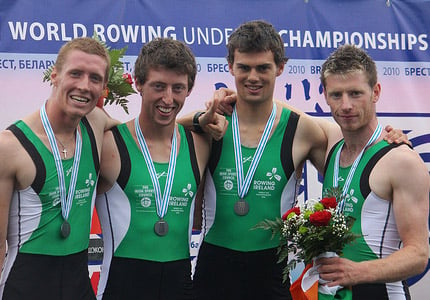
Silver in Belarus: Niall Kenny, Michael Maher, Mark O’Donovan and Justin Ryan
Rower of the Month awards: The judging panel is made up of Liam Gorman, rowing correspondent of The Irish Times, President of Rowing Ireland Anthony Dooley and David O'Brien, Editor of Afloat magazine. Monthly awards for achievements during the year will appear on afloat.ie and the overall national award will be presented to the person or crew who, in the judges' opinion, achieved the most notable results in, or made the most significant contribution to rowing during 2010. Keep a monthly eye on progress and watch our 2010 champions list grow.
Click this link for Irish Rowing detailsClick this link for the Latest Rowing News
Oarsome Foursome First to Row Round Britain
Four female rowers have become the first women ever to row around the coast of Britain. The women, who spent 51 days at sea, ended their epic 2,000-mile journey yesterday morning at Tower Bridge in London.
By becoming the first women ever to row around mainland Britain their time of 51 days 16hours 42minutes has been accepted for a Guinness World Record. Belinda Kirk, 35, from Bristol, Royal Navy nurse Laura Thomasson, 23, from Dover, IT support manager Beverley Ashton, 29, from Wantage, Oxfordshire and Angela Madsen, a wheelchair-bound 50-year-old grandmother and former US marine from Long Beach California are raising money for the services’ charity, Help For Heroes. When they set out from Tower Bridge in London on June 1, they were taking part in Virgin GB Row 2010 - the world’s toughest rowing race.
They were racing a team of four men around the British mainland. But when the male team gave up after less than two weeks, the women carried on alone and without any assistance for five more weeks. During that time the Seagals, as they are known were: swamped by huge waves which put the boat’s water maker out of action; almost sunk by a rogue wave that flooded the front cabin, survived storms, navigated some of the most treacherous tides on the planet, almost been mown down by ships, bombed by the RAF and they have run short of food.
Angela Madsen actually broke her finger setting off a flare to warn off a ship that was on a collision course. She then carried on rowing with a broken finger by strapping her hand to the oar. Because of bad weather and strong winds, their journey has taken three weeks more than expected and they packed enough food for just 40 days. And earlier this week a power failure onboard the boat meant they ration drinking water.
Sir Richard Branson who sponsored the event by awarding the first-ever Virgin Trophy to the winners, said: “Go Seagals!!! I knew I was right to back to girls in beating the boys in the first ever Virgin GB Row and I’m over the moon that such brave women have achieved a World Record in such a spectacular fashion! “This is why we set up the Virgin Trophy – Belinda, Angela, Laura and Beverley have pushed through extreme tiredness, hunger and serious injury to battle on and achieve the goal they set out to achieve. “Britain has something to be proud of this summer after all! I hope they will get all of Britain’s support when they record up the Thames on Thursday to claim their World Record and the Trophy!”
After passing under Tower Bridge at the end of their epic journey, the four women had an emotional reunion with friends and family they haven’t seen for more than seven weeks. They completely missed the world cup and Wimbledon passed them by.
Click this link for Irish Rowing details
Click this link for the Latest Rowing News
Silver Medal for Ireland at Under-23 World Champs
Ireland’s lightweight men’s quadruple scull took the silver medal behind Germany at the World Under-23 Championships in Brest in Belarus this morning. The crew of Niall Kenny, Michael Maher, Mark O’Donovan and Justin Ryan were the main challengers to the Germany, down the course, and an Ireland charge coming up to the finish threatened the eventual winners but could not close the gap. Britain, who finished well were over four seconds back on the Irish.

Silver in Belarus: Niall Kenny, Michael Maher, Mark O’Donovan and Justin Ryan
Under-23 World Championships, Brest, Belarus. Day Four (Irish interest)
Men,
Lightweight Pair – B Final (Places 7 to 12): 1 Austria 7:18.73, 2 Hong Kong 7:20.69, 3 Russia 7:23.12, 4 Ireland (P Hanily, A English) 7:28.46, 5 Brazil 7:34.12, 6 Canada 7:36.04.
Lightweight Quadruple Scull – A Final: 1 Germany 6:14.07, 2 Ireland (N Kenny, M Maher, M O’Donovan, J Ryan) 6:15.86, 3 Britain 6:20.06; 4 Italy 6:20.74, 5 France 6:23.26, 6 Greece 6:24.45.
Lightweight Single Scull – A Final: 1 Iran 7:17.93, 2 Britain (P Chambers) 7:19.59, 3 Brazil 7:23.38.
Women,
Single Scull – B Final (Places 7 to 12): 1 Serbia 8:15.26, 2 Netherlands 8:15.58, 3 Ireland (L Dilleen) 8:16.60, 4 Czech Republic 8:21.18, 5 Britain 8:22.56, 6 Spain 8:33.38.
Lightweight Double Scull – B Final (Places 7 to 12): 1 Spain 7:43.76, 2 Ireland (C Lambe, S Dolan) 7:44.24, 3 United States 7:44.57, 4 Denmark 7:46.44, 5 Netherlands 7:54.42, 6 Russia 7:54.72.
